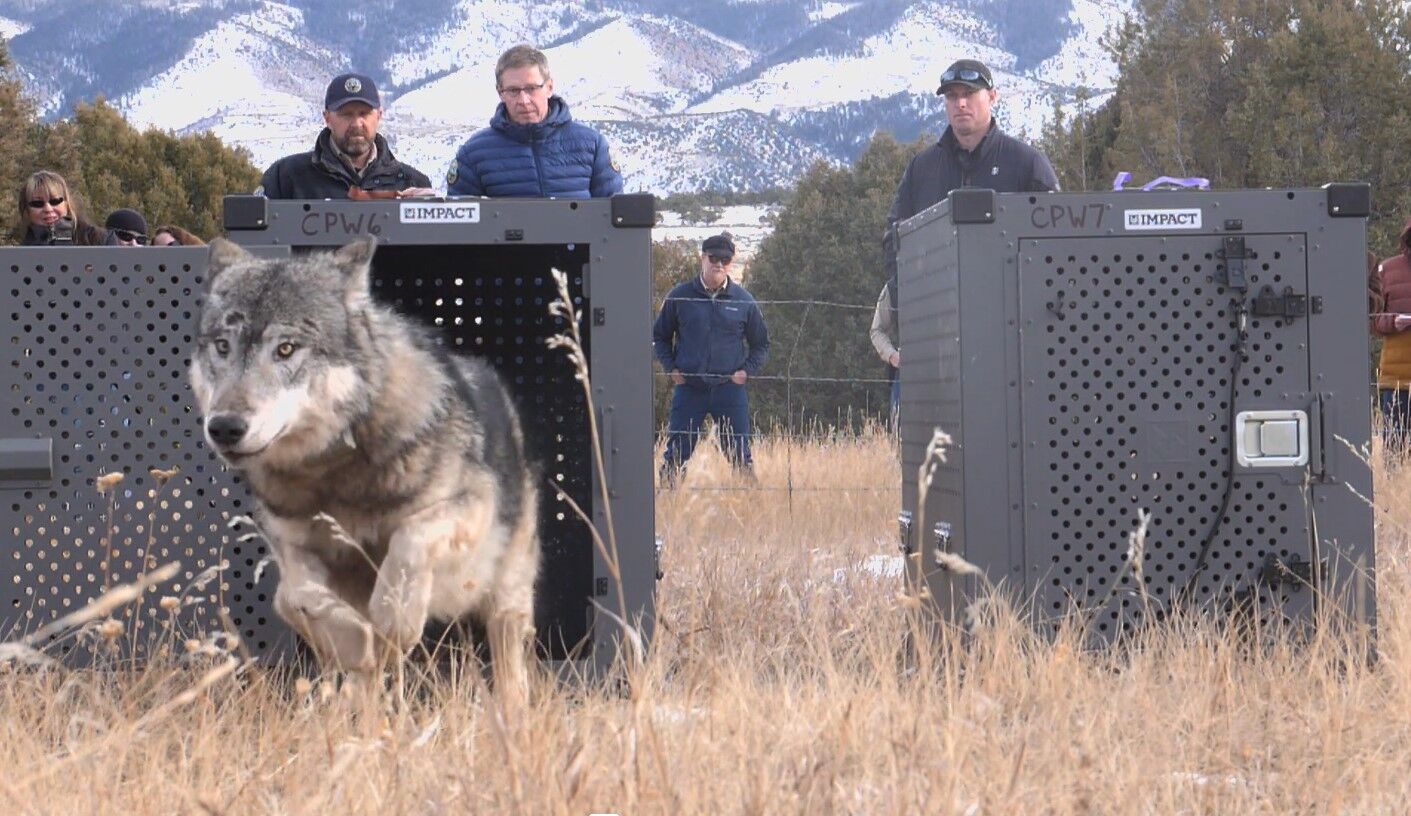Recently released wolves into Colorado come from depredating packs in Oregon

Two wolves released on Dec. 19 in Grand County came from a pack that Oregon officials said preyed on livestock in the last two years.
The Five Points Pack wolves injured one calf and killed another in separate depredations in July of 2023; killed a cow on Dec. 5, 2022; and, injured a 900-pound yearling heifer on July 17, 2022, according to Oregon Department of Fish and Wildlife Livestock Depredation Investigations.
Two wolves from the pack – 2302-OR, a juvenile female, black color and 68 pounds, and 2303-OR, a juvenile male, gray color, 76 pounds – were among the five from Oregon that arrived in Colorado several days ago and released in the Western Slope, the culmination of years of planning for a program that has stoked political tensions and is likely to lead to conflicts as the predators make the valleys, lakes and peaks of the north-central Rocky Mountains their new home.
On July 21, Oregon wildlife officials authorized the killing of up to four wolves from the Five Points Pack after two attacks on livestock within a week, which were the second and third depredations in the area within eight months. United States Department of Agriculture employees killed two adult females, one adult male, and a yearling female from the pack by Aug. 4.
The other wolves released in Colorado – 2304-OR, a juvenile female, gray color, 76 pounds, and 2305-OR, a juvenile male, black color, 93 pounds – both came from the Noregaard Pack. The Noregaard Pack was involved in the confirmed killing of a calf on June 15, according to Oregon wildlife officials.
The fifth – 2307-OR, an adult male, gray color, 108 pounds – came from the Wenaha Pack. This pack was involved in the confirmed killing of a 7-month-old calf on Sept. 18 and a cow on Oct. 25, Oregon officials said.
Colorado Parks and Wildlife Director Jeff Davis and his staff testified before the House Agriculture Committee on Sept. 12, 2023 that they would do everything possible not to bring “problem” wolves to Colorado. An email to the agency asking why it released wolves from the chronically depredating Five Points pack had not been answered.
At the meeting in Meeker hosted the same night of the release, rancher Don Gittleson said Colorado Parks and Wildlife staff again assured ranchers the wolves were not from depredating packs.
John Williams, the co-chair of the Oregon Cattlemen’s Association Wolf Committee who serves as the Eastern Oregon Wolf Committee chair, said there is controversy whether removing a specific problem wolf from a depredating pack will stop the depredation. He maintained there is no research to support that and the findings on the ground do not support the theory. Rather, he said, wolf pack size has some bearing on whether a pack depredates livestock.
“Once a pack starts to depredate on livestock, they tend to include livestock in their diet in the future,” he said. “It does not say they always eat livestock but it’s more like they acquire a taste for it, they like it, and they stay on it and they may not.”
Williams, who visited the Gunnison area, said the release sites are very close in proximity to private lands, and, with wolves traveling hundreds of miles over the course of a week, the scale of wolf territory is sizable. To answer the question of what wolves are going to eat isn’t unlike a group of six teenagers in a car driving down a street filled with restaurants, he said.
“One of them will pipe up and say they’re hungry and the next restaurant they come to is the one they’ll likely turn into unless the alpha male, the driver in this instance, says they’re going somewhere else,” he said.
Williams said overanalyzing what a wolf will eat next is just that – overanalyzing.
“That’s a long answer to your short question of will these wolves that were sent to Colorado going to depredate on livestock,” he said. “The answer is yes. Right away? I don’t know.”
In Oregon, Williams said the highest depredation incidences tend to be during times when cattle are concentrated from gathering in the fall in August through December. Depredations slow down when cattle are close to the ranches and elk are readily available.
“The simple answer is once a pack of wolves recognizes that steak is good, they will include that in their diet in the future,” he said. “The Five Points Pack had four wolves removed because they were chronically depredating in July and August.”
Williams said one of the ranchers who experienced depredation losses from the Five Points Pack reported a 28% decrease in conception rates and that about 20 head of calves missing when pairs were gathered in the fall. Those calves are likely wolf kills, but the calves were never found, something that isn’t uncommon, he said.
He added that dead cows and calves is not the ranchers’ biggest issue – reduced conception rates, weaning weights, drops in body condition scores, and increased management costs are.
“The confirmed kill list is a small piece of what’s actually happening out there on the ground,” he said. “The Five Point Pack is a problem pack and has been. They have taken four wolves out of it and it sounds to me like someone tried to convince (CPW) that they took the four wolves out and they haven’t depredated since then or haven’t been seen depredating since then, that the problem has been solved in that pack and that’s just not the case.”
The release of five wolves comes just six days after Colorado Parks and Wildlife confirmed a wolf attack on a calf owned by Gittleson. The Jackson County rancher attended a Colorado Parks and Wildlife meeting in Moffat County following the release.
The Steamboat Radio reported that Gittleson answered questions from other ranchers in the room, and that he told the group he is particularly angry with the Colorado Wolf and Wildlife Center hosting a wolf naming contest among students in grades 5-8. The contest included an educational script for the teacher to utilize.
“Kids shouldn’t be put in the middle of this,” Gittleson said.
Rachel Gabel is Assistant Editor of The Fence Post Magazine. She is also a columnist of Colorado Politics and The Gazette newspapers. This article has been reprinted with permission from The Fence Post Magazine.














